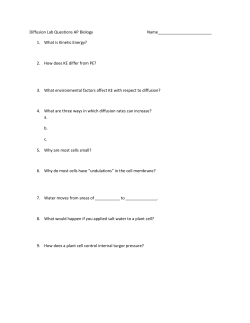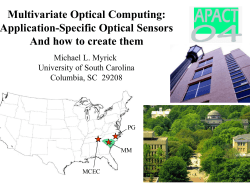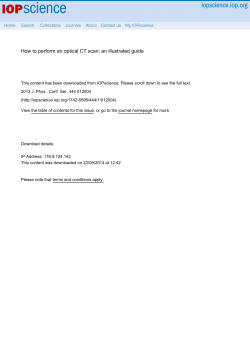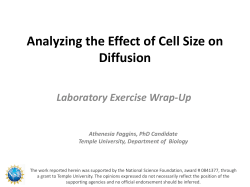
1. Optical properties 2. How to measure optical properties 4. Complex tissues
Origins of optical contrast in tissues Steven L. Jacques jacquess@ohsu.edu http://omlc.ogi.edu Depts. of Biomedical Engineering and Dermatology Oregon Health & Science University, Portland OR, USA 1. Optical properties 2. How to measure optical properties 3. Light transport 4. Complex tissues Optical transport in tissues • Primary unscattered light - coherence, polarization • Secondary multiply scattered light - transition to diffusion - diffusion of light Monte MonteCarlo Carlosimulation simulation of ofphoton photonmigration migration air tissue 5mmx5mm esophagus @ 630 nm wavelength 1 µ s (1-g) = 1 mm Monte Carlo W cm2 per W incident power z [mm] r [mm] 1 µ s (1-g) = 1 mm W cm2 per W incident power z [mm] r [mm] optical fiber in scattering medium 1 µs(1-g) 2 Irradiance E [W/cm ] Α1 E Α1 Α 2 E θ A1 = A2 cos θ Fluence rate F 2 [W/cm ] mirror E mirror Estd Pdetected.std F P + milk/ink Clear water add water to match front boundary +matching 0.56 mm] Simple 1-D approximation that applies to a broad flat-field beam of irradiance (Eo [W/cm2]) The backscatter term k [dimensionless] k To a first approximation, the total diffuse reflectance Rd behaves as if there were a single pathlength L = 7δ for photons, where δ is 1/e the optical penetration depth. Rd ≈ e−Aδµ a = e total − A 3(1+N ' ) 1 0.9 A=7 A=8 0.8 € 0.7 R total 0.6 0.5 0.4 0.3 0.2 0.1 -2 10 0 10 2 10 N' = µs'/µa 4 10 6 10 Residuals 0.05 0 -0.05 -2 10 0 10 2 10 N' = µ '/µ s a 4 10 6 10 Fluence rate = speed of light x photon concentration F=cC [cm / s])(44 ps) ps) (c [cm/s])(44 2 -2 cm 11W W / cm € 1 cm 1 cm 1 cm En λ = 1.1×1010 photons / cm 3 Cph = c hc En λ 1000 = = 1.8×10−13 moles / liter c hc N av for λ = 488 nm, n = 1.33 € fluence rate concentration F = = ccC C F [W cm-2] [J cm-3] [cm/s] speed of light time-resolved diffusion diffusivity, C(r C(r,t),t)== UU oo [J cm-3] [J] χ = cD [cm2/s] 2 r 2 −r /(4cDt ) ) exp (e 4cDt 3/ 2 (4(4!cDt) πcDt)3/2 [cm-3] Fick’s 1st Law of diffusion ∂C J = −χ ∂x Diffusivity [cm2/s] € χ = cD 1 1 D= ' 3 µa + µs Fick’s 2nd Law of diffusion 2 ∂ C ∂C =χ x ∂t ∂x € time-resolved fluence rate 2 −r /(4cDt ) r2 exp () −µ a ct 4cDt F(r,t) = c Uo o 3 /exp(-µ 2 act) (4!cDt)3/2 e F(r ,t) = cU (4 πcDt) [W cm-2] [cm/s][J] [cm-3] C(r,t) e absorption F(r,t) F(r,t) radiant exposure ∞ H(r) = ∫ H(r) = ∞ F(r,t) dt ∫ c C(r,t) exp(-µ ct) dt a 0 0 [J cm-2] € [W cm-2] −r /δ [s] exp(- µea/D r) H (r ) = U o = Uo 2 4!Dr 4 πµ aδ r € frequency [W] [J] [s-1] P=U f Po = Uo f o € in the limit ff ∅ →∞∞ 00 Uo ∅ U → o steady-state fluence rate −r /δ e exp(- µa/D r) F(r ) = P F(r) = Po o 4 πDr 4!Dr [W cm-2] [W] € [cm-2] F(r) F(r) Frequency-domain Diffusion Theory: Isotropic point source in infinite medium source: f = 400 MHz, So = 1 W, Mo = 1.0 medium: µa = 1.0 cm-1, µs(1 - g) = 10.0 cm-1, nt = 1.33 S(t) = S0 (1+ M 0 sin(ωt)) e −2rk " F(r ,t) = S0 Tss(r )+ M 0 sin(ωt − k'r ) 4 πDr € = S0Tss(r )(1+ M 0 e −r (2k "−1/δ ) sin(ωt − k'r )) e −r /δ Tss(r ) = 4 πDr € Modulation M = M 0e−r(2k"−1/δ ) € Phase € P = k'r where 1/ 2 2 1/ 2 1 ω k" = 1+ + 1 δ 2 µ a c 2 1/ 2 1 ω k' = 1+ − δ 2 µ ac € where a = cos( b) δ 1/ 2 a 1 = sin( b) δ 2 1/ 4 ω a = 1+ µ c a ω 1 b = arctan 2 µ ac ω µ ac € = #cycles per photon lifetime Origins of optical contrast in tissues Steven L. Jacques jacquess@ohsu.edu http://omlc.ogi.edu Depts. of Biomedical Engineering and Dermatology Oregon Health & Science University, Portland OR, USA 1. Optical properties 2. How to measure optical properties 3. Light transport 4. Complex tissues
© Copyright 2025









![DigiLink Artel ships the DLC200 configured as follows: [DLC200]](http://cdn1.abcdocz.com/store/data/000321508_1-5ea6363a609c8f3a147a63246271aae9-250x500.png)











